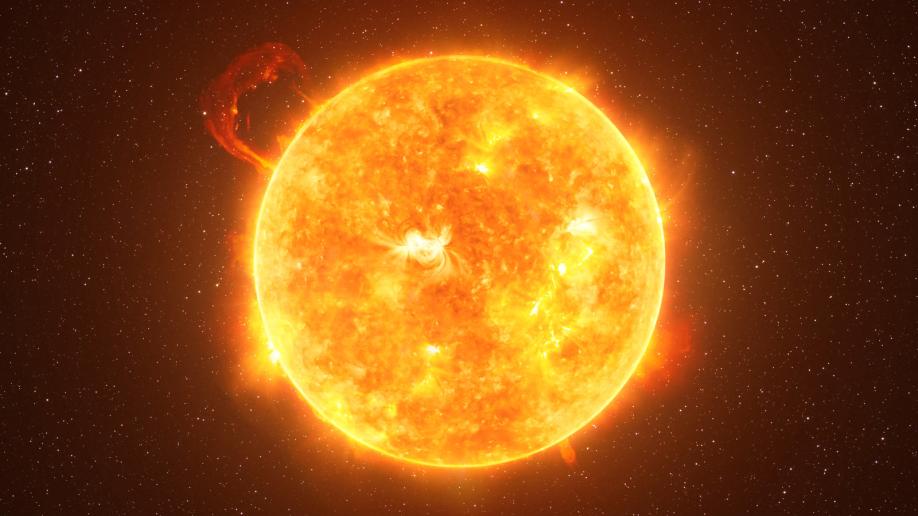What Role Do Solar Flares and Coronal Mass Ejections Play in Triggering Geomagnetic Storms?
The Sun, our celestial companion, is a dynamic and ever-changing entity. Its activity, characterized by solar flares and coronal mass ejections (CMEs), has a profound impact on Earth's magnetosphere and can trigger geomagnetic storms. Understanding this intricate relationship is crucial for safeguarding Earth's infrastructure and technology from space weather disturbances.

I. Solar Flares
A) Process Of Solar Flares
Solar flares are sudden and intense bursts of energy released from the Sun's atmosphere, the corona. They originate from the interaction of magnetic fields in the corona, which become twisted and tangled, storing vast amounts of energy. When this energy is released, it manifests as a solar flare, emitting intense radiation across the electromagnetic spectrum, from X-rays to radio waves.
B) Classification Of Solar Flares
- A-Class Flares: These are the weakest type of solar flares, producing X-ray emissions with a peak flux of 10-7 watts per square meter (W/m2).
- B-Class Flares: Slightly more intense than A-Class flares, with X-ray emissions ranging from 10-6 to 10-5 W/m2.
- C-Class Flares: Moderate-intensity flares with X-ray emissions between 10-5 and 10-4 W/m2.
- M-Class Flares: Significant flares that can disrupt radio communications and cause auroral displays. Their X-ray emissions range from 10-4 to 10-3 W/m2.
- X-Class Flares: The most powerful type of solar flares, with X-ray emissions exceeding 10-3 W/m2. These flares can have severe impacts on Earth's magnetosphere and trigger intense geomagnetic storms.
C) Impact Of Solar Flares On Earth's Magnetosphere
- Disruption of Radio Communications: Solar flares can disrupt radio communications, particularly in the high-frequency (HF) range, due to the ionization of the Earth's atmosphere. This can affect aviation, marine, and military communications.
- Auroral Displays: Solar flares can trigger auroral displays, also known as the Northern Lights and Southern Lights, when charged particles from the Sun interact with Earth's atmosphere near the magnetic poles.
- Geomagnetic Storms: Intense solar flares can trigger geomagnetic storms, which are disturbances in Earth's magnetic field. These storms can have a range of effects, including power grid disruptions, satellite malfunctions, and communication outages.
II. Coronal Mass Ejections (CMEs)
A) Process Of CMEs
Coronal mass ejections (CMEs) are massive clouds of charged particles and magnetic fields that erupt from the Sun's corona. They are formed when magnetic field lines in the corona become unstable and reconnect, releasing vast amounts of energy. CMEs can travel through the solar system at speeds ranging from a few hundred kilometers per second to several thousand kilometers per second.
B) Characteristics Of CMEs
- Speed: CMEs can travel at speeds ranging from a few hundred kilometers per second to several thousand kilometers per second.
- Density: The density of CMEs can vary significantly, ranging from ten to hundreds of protons per cubic centimeter.
- Magnetic Field: CMEs carry their own magnetic field, which can interact with Earth's magnetic field and trigger geomagnetic storms.
C) Impact Of CMEs On Earth's Magnetosphere
- Geomagnetic Storms: CMEs are the primary cause of geomagnetic storms. When a CME interacts with Earth's magnetic field, it can compress the magnetosphere and generate electric currents in the ionosphere, leading to geomagnetic storms.
- Disruption of Satellite Operations: Geomagnetic storms caused by CMEs can disrupt satellite operations by causing temporary malfunctions or even permanent damage.
- Power Grid Disturbances: Geomagnetic storms can induce currents in power grids, leading to voltage fluctuations and even power outages.
III. Triggering Geomagnetic Storms
Solar flares and CMEs can trigger geomagnetic storms through a series of complex interactions between the solar wind, Earth's magnetic field, and the ionosphere.
A) Interaction Of Solar Particles With Earth's Magnetic Field

When solar flares or CMEs erupt, they release charged particles, including protons and electrons, which travel through the solar wind and interact with Earth's magnetic field. These particles can be deflected or trapped by Earth's magnetic field, depending on their energy and the orientation of the magnetic field lines.
B) Compression Of Earth's Magnetosphere
When a CME interacts with Earth's magnetic field, it can compress the magnetosphere, the region of space around Earth that is dominated by its magnetic field. This compression can trigger a geomagnetic storm by generating electric currents in the ionosphere, the layer of Earth's atmosphere where the solar wind interacts with Earth's magnetic field.
C) Generation Of Electric Currents In Earth's Ionosphere

The interaction between the solar wind and Earth's magnetic field generates electric currents in the ionosphere. These currents flow along magnetic field lines and can cause disturbances in Earth's magnetic field, leading to geomagnetic storms.
D) Role Of The Interplanetary Magnetic Field (IMF)
The interplanetary magnetic field (IMF) is the magnetic field carried by the solar wind. The orientation of the IMF relative to Earth's magnetic field plays a crucial role in determining the severity of a geomagnetic storm. When the IMF is oriented southward, it can connect more easily with Earth's magnetic field, allowing more solar particles to enter Earth's magnetosphere and triggering more intense geomagnetic storms.
IV. Consequences Of Geomagnetic Storms
Geomagnetic storms can have a range of consequences for Earth's infrastructure and technology.
A) Power Grid Disruptions
Geomagnetic storms can induce currents in power grids, leading to voltage fluctuations and power outages. These outages can disrupt critical infrastructure, such as hospitals, transportation systems, and communication networks.
B) Satellite Malfunctions
Geomagnetic storms can disrupt satellite operations by causing temporary malfunctions or even permanent damage. This can affect satellite communications, navigation systems, and Earth observation satellites.
C) Communication Outages
Geomagnetic storms can disrupt radio communications, particularly in the high-frequency (HF) range. This can affect aviation, marine, and military communications.
D) Navigation System Errors
Geomagnetic storms can cause errors in navigation systems that rely on Earth's magnetic field, such as compasses and GPS systems. This can affect navigation for ships, aircraft, and ground vehicles.
V. Conclusion
The Sun's activity, manifested through solar flares and coronal mass ejections, plays a significant role in triggering geomagnetic storms that can impact Earth's infrastructure and technology. Understanding the intricate relationship between solar activity and geomagnetic storms is crucial for developing effective space weather forecasting and mitigation strategies to protect critical infrastructure and ensure the smooth operation of technology in the face of space weather disturbances.
Continued research and monitoring of solar activity, international cooperation in space weather forecasting, and the development of mitigation strategies are essential to minimize the impacts of geomagnetic storms and ensure the resilience of Earth's infrastructure and technology in the face of space weather hazards.
YesNo

Leave a Reply